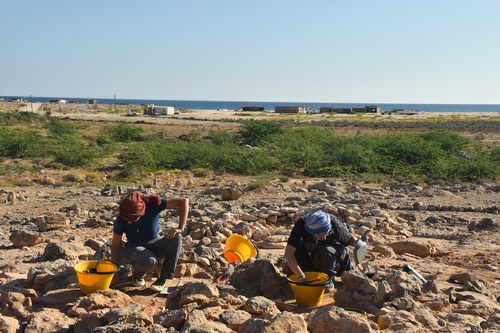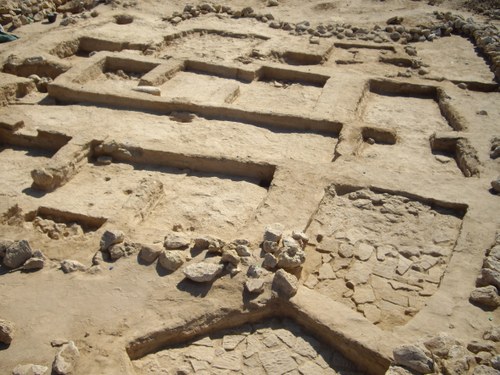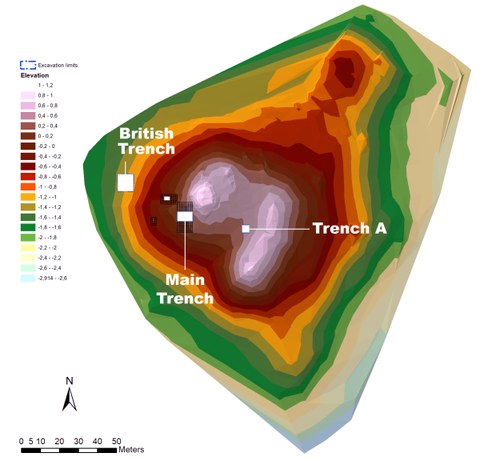
Ra's al-Hadd, Sultanate of Oman
Research on the settlement dynamics between Middle Holocene and the Iron Age

Early Bronze Age Necropolis, Ra's al-Hadd HD-7, Sultanate of Oman
Scientific director:
- Prof. Maurizio Cattani
Field supervisor:
Activities:
Topographic and GIS survey, stratigraphic excavations, 3D photogrammetry and LiDAR documentation, anthropological and bioarchaeological analyses, artefact and pottery studies, radiocarbon dating.
Chronology:
Necropolis in use during the Early Bronze Age, specifically the first half of the 3rd millennium BC (ca. 3000–2500 BC), at the transition between the Hafit and Umm an-Nar periods.
Description:
The HD-7 cemetery, located on a rocky terrace overlooking the sea at Ra's al-Hadd (Eastern Sharqiyah, Sultanate of Oman), is part of a broader archaeological and ancient funerary landscape that includes the nearby sites of HD-5, HD-6 and HD-10. The tombs are arranged in small clusters, each comprising 3 to 6 graves. While earlier excavations by international teams had explored several structures, recent urban development endangered some of the remaining unexcavated tombs, prompting renewed investigations by the University of Bologna since 2023.
The project started in 2022 with a first survey, followed by three excavation campaigns that took place in January 2023, January 2024 and January 2025, with the principal financial support of the University of Bologna and the Italian Ministry of Foreign Affairs and International Cooperation (MAECI).
The cairns typically feature double or triple concentric walls. Notably, several of these structures use whitish beach-rock for the external perimeter, a local variant of the classic 'Hafit tomb' typology.
Tomb 1 of HD-7.12 group and Tomb 1 of HD-7.2 group were the best preserved and yielded numerous grave goods and a substantial quantity of human remains. A high proportion of burnt bones indicate the coexistence of two funerary practices: both inhumation and cremation.
The artefact assemblage includes a substantial number of personal ornaments - over one thousand beads! - made from shell, stone, and animal bone. Several of these display complex manufacturing techniques, including signs of controlled heating and pyrotechnological treatment, suggesting an advanced understanding of material properties. While no pottery is attributable to the Hafit period, ceramic fragments from the more recent tombs reflect early Umm an-Nar occupation.

Joint Hadd Project
The research is part of the Italo-French collaboration "Joint Hadd Project", started in 1985 in partnership with the Ministry of Heritage and Tourism of the Sultanate of Oman, the Italian Ministry of Foreign Affairs, and the International Association for Mediterranean and Oriental Studies (ISMEO).
The project focuses on the exploration of Bronze Age sites at Ra's al-Jinz and Ra's al-Hadd, and on understanding how prehistoric Omani society changed from a set of relatively isolated local communities into a supra-regional entity of major importance within the exchange networks of Middle Asia.
In the coastal area of Ra's al-Hadd, excavations at the sites of HD-5 and HD-6 have provided important data on human occupation between the 4th and 3rd millennia BC.
- At HD-5 (IV-III mill. BCE), investigations directed by Federico Borgi and Elena Maini have documented communities of fishers and gatherers actively exploiting coastal resources.
- At HD-6, dated to between 3000 and 2700 BC, a residential complex composed of modular, rectangular buildings made of standardised mudbricks was identified. In the site's central area, three construction phases were documented: the first with compact, sandy-matrix bricks; the second and third marked by the addition of a perimeter stone wall and tripartite buildings. The final phase corresponds to the site's abandonment and the formation of carbon-rich layers, followed by reoccupation featuring oval and circular dry-stone huts. The material assemblage includes numerous metal artefacts (hooks, points, small daggers), stone and shell ornaments, and very rare imported ceramic fragments. Particularly notable are several circular clay ovens built near the structures, likely used for processing foodstuffs.

The Umm an-Nar site of HD-1
Co-direction:
- University of Bologna
- University of Wisconsin-Madison
UniBO coordinators/leaders:
- Prof. Maurizio Cattani: scientific director
- Florencia Inés Debandi: field supervisor
Uni. Madison coordinator:
- Prof. J. Mark Kenoyer
Description:
The archaeological complex of HD-1 is notable for the abundant presence of Indus Civilisation pottery (second half of the 3rd millennium BC) and represents an exceptional context for understanding interactions between the Arabian Peninsula and the Indus Valley, within the broader framework of exchanges between Mesopotamia and the Indo-Pakistani Subcontinent.
Research at the site took place between 2016 and 2019, in collaboration with the University of Wisconsin-Madison, and focused on updated palaeobiological sampling and the analytical study of productive activities. The site was likely a seasonal station used by fishers and sailors, with intensive storage and processing activities linked to what must have been a 3rd-millennium-BC harbour. This is suggested by its strategic location on the coastal barrier separating the open ocean from a wide lagoon, suitable for hosting large vessels used in deep-sea navigation.
Contacts
Maurizio Cattani
Francesca Barchiesi

Lions Club "Alberto Pio" Carpi
In 2025, the Lions Club "Alberto Pio" of Carpi (MO) sponsored the archaeological mission and hosted a public lecture at the "A. Loria" Library in Carpi. Further information is available in the Events section!